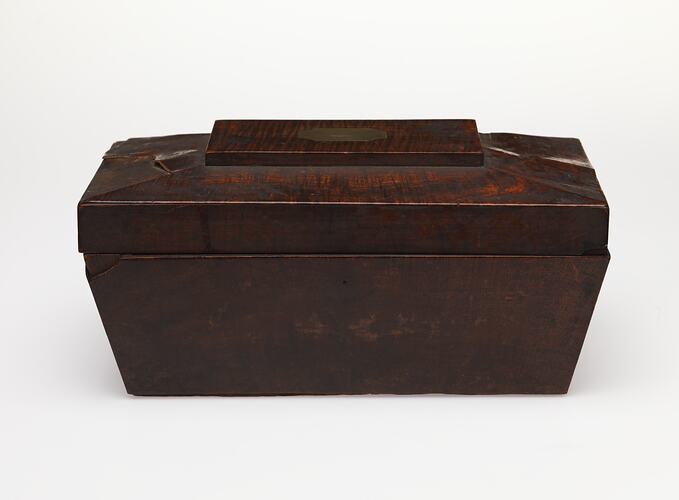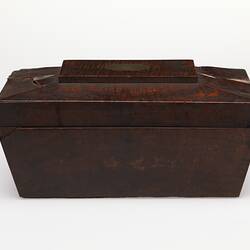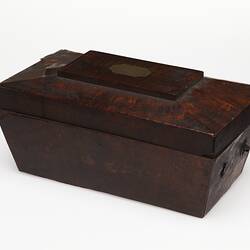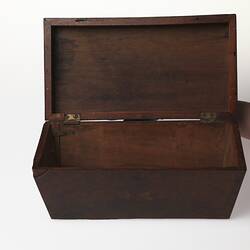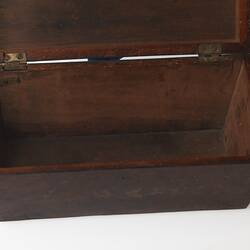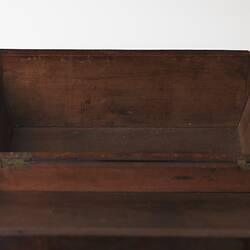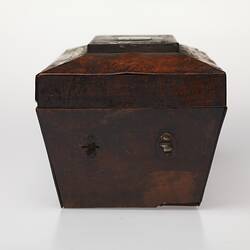Summary
Mahogany wood tea caddy, believed to be the first item of non-Indigenous manufacture ever made in Victoria, and the only surviving item made at the Port Philip camp at Sullivan Bay (near Sorrento) in 1803. Extensive research has led to the conclusion that it was probably made by convict James Grove, who sailed on the HMS Calcutta, and was then given to the ship's commander Lieutenant-Governor David Collins.
Physical Description
A mahogany tea caddy, in the form of a sarcophagus, with a hinged lid. The outside is covered with hand cut blackwood wattle veneer. On the top is a rectangular brass plaque engraved with a camel head and the initials 'D.C.'. Damaged brass handles are on either side. Inside are evidence of two partitions which are now missing.
Significance
Collins had been enlisted by the British Government to establish a settlement on Port Phillip Bay, as its Lieutenant-Governor, due to fears that the French were planning to do something similar. The expedition consisted of two ships: the HMS Calcutta and The Ocean, and included officers, a marine detachment, free settlers and 301 convicts. They landed at Sullivan Bay (near present day Sorrento), in October 1803, an area chosen due to its strategic location near the entrance to the bay. A camp was soon establish but its sandy soil and a lack of a reliable supply of drinking water eventually led to the settlement being abandoned in early 1804. At which time Collins and the surviving members headed south to Hobart.
James Grove had been a skilled engraver in Birmingham when, in 1802, he was persuaded to engrave a set of plates to counterfeit Bank of England bank notes. Arrested, he was sentenced to death, but this was later commuted to transportation for life. He was transferred to the HMS Calcutta in April 1803, just before its voyage under Collins command to establish the new settlement at Port Phillip. His wife and son were able to accompany him on the journey. Well-spoken and educated, he was soon a trusted and well privileged prisoner, establishing lasting friendships with Collins and the chaplain Robert Knopwood. After landing at Sullivan Bay, Grove was appointed to night watch and showed his entrepreneurial skills by manufacturing alkali, used in the manufacture of soap, from seaweed he gathered from the beach. He also manufactured tea from the native tea trees, which he described in a letter to home as `equal to any of the common black teas sold in England'.
It is believed that the tea caddy was made during his time there, from locally sourced blackwood (acacia melanoxylon) veneered over a carcass made from reclaimed mahogany, using tools belonging to the ship's carpenter. The metal components also appear to be recycled, including the hinges which are cut down from larger ones. It was designed as a gift for Collins, with his crest and initials on an engraved plaque on the lid, as part of Grove's petition to be pardoned. It seemed to have work as, by the time the settlement was relocated to Tasmania, his status in official documents had altered from prisoner to settler. In 1806, at the special request of Collins, Grove was granted a conditional pardon, and by 1808 he became the government storekeeper.
Extensive forensic and scientific analysis was carried out on the caddy on behalf of the Tasmanian Museum and Art Gallery and the National Museum of Australia, with both concluding that the tea caddy dated to the pre 1810 period, and that nothing had been altered or added to it since then, except for replacement of the wooden bottom.
More Information
-
Collecting Areas
Public Life & Institutions, Home & Community, Working Life & Trades
-
Acquisition Information
Cultural Gifts Donation from Christopher Seaman, Jon Davies, Mr Antony Davies, 29 May 2017
-
Acknowledgement
Donated through the Australian Government's Cultural Gifts Program by Jon Paul Davies and Christopher Robert Seaman
-
Made For
Lieutenant Governor David Collins, Sorrento, Mornington Peninsula, Victoria, Australia, 1803
-
Maker
Mr James Grove, Sorrento, Mornington Peninsula, Victoria, Australia, 1803
-
Inscriptions
Engraved on metal plate on lid: D.C.
-
Classification
-
Category
-
Discipline
-
Type of item
-
Overall Dimensions - Closed
330 mm (Length), 178 mm (Depth), 165 mm (Height)
This object is styled as a sarcophagus. The base dimensions are Length 280mm x Depth 135mm
-
Keywords
Victorian Pioneers, European Settlement of Australia, Tasmanian Colonial Governors, Tea, Tea Accessories, Convicts
